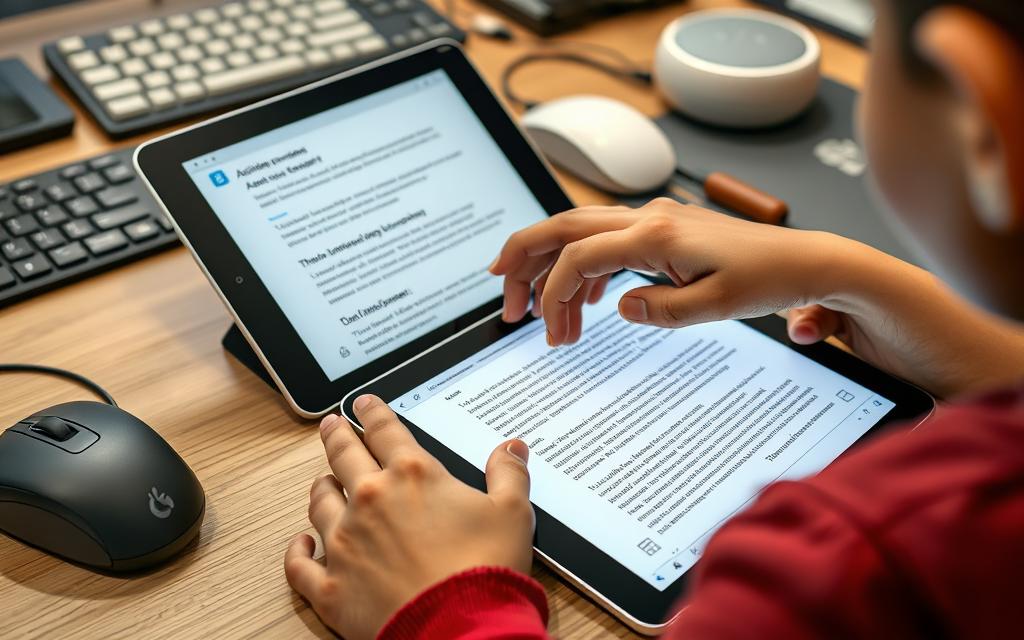In the United States, 6.7 million students with disabilities are served under the Individuals with Disabilities Education Act (IDEA). This represents 13% of the public school population. These students benefit from assistive technology, which plays a transformative role in their education.
IDEA defines assistive technology as tools that increase, maintain, or improve functional capabilities. This legal framework ensures that students have access to devices and software tailored to their needs. Such tools can range from speech-to-text programs to adaptive computer systems.
Organizations like ALSO emphasize community inclusion through self-determination and quality of life. By integrating technology into education, students gain greater independence and improved academic outcomes. This approach fosters both social and academic success.
Key solutions include adaptive devices, communication tools, and smart environmental controls. These innovations provide students with the access they need to thrive. For more insights, visit this resource.
Introduction: The Role of Technology in Empowering Students With Disabilities
Education has long been a challenge for individuals with disabilities, but modern advancements are changing the game. Historically, 22% of adults with disabilities had less than a high school education, reflecting significant disparities. Today, technology is bridging these gaps, offering new opportunities for academic and personal growth.
Systematic reviews from 2009 to 2020 show that assistive tools increase academic engagement. Since 2017, the adoption of these solutions has surged, leading to measurable improvements in learning outcomes. For example, college students report enhanced well-being and self-efficacy through the use of adaptive devices.
Beyond academics, technology also addresses psychosocial challenges. A study by the University of Cincinnati found that assistive tools reduce anxiety and improve confidence. These benefits extend beyond the classroom, fostering independence and self-perception.
Collaborative support networks, such as IEP Teams, play a crucial role in this transformation. These teams work together to identify and implement tailored solutions for each individual. Organizations like ALSO emphasize the importance of self-determination and quality of life, aligning with their Heart Work philosophy.
“Technology is not just a tool; it’s a bridge to independence and empowerment.”
By integrating innovative solutions into education, individuals with disabilities gain the skills and support they need to thrive. This approach not only enhances academic success but also fosters a sense of belonging and purpose.
How Does Technology Help Students With Disabilities Become More Independent?
Innovative tools are reshaping the way individuals with unique challenges navigate their educational journeys. From simple aids to advanced systems, these solutions are designed to meet diverse needs and foster autonomy.
Assistive Technology: A Game-Changer for Learning
Assistive tools come in various forms, each tailored to specific requirements. Low-tech options, like weighted pencils and graphic organizers, provide foundational support. These simple yet effective aids are often the first step toward independence.
On the other hand, high-tech devices like Voiceitt’s AI-powered speech translation software break communication barriers. This tool enables individuals with non-traditional speech patterns to express themselves clearly. Similarly, Eyedriveomatic’s eye-controlled wheelchair offers physical independence, allowing users to navigate their environments with ease.
Custom Solutions for Diverse Needs
Personalized learning is a cornerstone of modern education. Research by Edmentum highlights how self-paced programs reduce anxiety and improve outcomes. By allowing individuals to learn at their own speed, these tools foster confidence and independence.
Organizations like ALSO take a collaborative approach, working with occupational therapists and speech pathologists to develop tailored solutions. This teamwork ensures that each individual receives the support they need to thrive. For more insights, explore this resource.
Whether low-tech or high-tech, these tools are transforming lives. They provide the access and resources necessary for individuals to achieve their full potential. By embracing these innovations, we can create a more inclusive and empowering future.
Types of Assistive Technology for Students With Disabilities
The range of assistive devices available today is both diverse and impactful. These tools are designed to address specific challenges, ensuring that every individual has the support they need to succeed. From simple aids to advanced systems, the options are tailored to meet a variety of needs.
Low-Tech Tools: Simple Yet Effective
Low-tech solutions are often the first step toward independence. Tools like weighted pencils and graphic organizers provide foundational support. These cost-effective options are widely accessible, with 75% of classrooms already equipped with basic aids like tape recorders.
These devices may seem simple, but their impact is significant. They help individuals organize their thoughts and complete tasks with greater ease. For many, these tools are the gateway to more advanced technologies.
High-Tech Innovations: Breaking Barriers
High-tech assistive technology takes accessibility to the next level. OCR systems, for example, convert printed text into audio, enabling visually impaired students to access textbooks. This software is a game-changer in special education.
Another standout is the JAWS screen reader, which integrates with Braille keyboards for seamless navigation. XB Chat’s ADA-compliant interface supports group learning through 5-user video conferencing. These tools break communication barriers and foster collaboration.
By combining low-tech and high-tech solutions, educators can create a more inclusive learning environment. These devices empower individuals to achieve their full potential, paving the way for a brighter future.
Real-World Examples: Technology in Action
Across the U.S., innovative programs are transforming lives for people with disabilities. These initiatives showcase how technologies foster independence and improve quality of life. From smart homes to advanced tools, real-world applications are making a tangible difference.
Success Stories: From Classroom to Independence
David Slack and Tony Harper, residents of Lebanon, Tennessee, are prime examples of how technologies can empower individuals. Their smart home features medication robots and security cameras, reducing reliance on 24/7 care. This approach has allowed them to live more autonomously while maintaining safety and support.
Tennessee’s $400M Enabling Technology initiative has been a game-changer. Funded by the American Rescue Plan, this program has reduced the need for constant care to just 20 hours per week for many participants. Since its pilot in 2017, the initiative has seen a 200% increase in enrollment, highlighting its success.
Programs and Initiatives Making a Difference
PowerSchool’s IEP compliance tracking systems are another standout example. These tools automate document management, ensuring IDEA compliance and streamlining work for educators. This training and support system helps schools focus on delivering personalized education.
Tennessee is also pioneering virtual reality (VR) environments tailored for people with disabilities. These VR spaces provide immersive training and social interaction opportunities, further enhancing independence and academic performance.
| Initiative | Impact |
|---|---|
| Tennessee’s Enabling Technology | Reduced care hours, increased enrollment |
| Smart Home Solutions | Enhanced autonomy for residents |
| PowerSchool’s IEP Systems | Streamlined compliance and support |
| VR Environments | Improved training and social interaction |
These programs and tools are not just changing lives—they’re creating a more inclusive future. By leveraging technologies, we can help people achieve their full potential and thrive in every aspect of life.
Conclusion: The Future of Technology and Independence for Students With Disabilities
The future of education for individuals with disabilities is being reshaped by innovative solutions. Programs like Tennessee’s Enabling Technology initiative demonstrate the potential of smart home systems, reducing caregiver hours by 63%. These advancements are not just improving access but also fostering greater independence.
Virtual reality (VR) integration is expanding experiential learning opportunities, offering immersive environments for skill development. With a $5.5M investment serving over 2,000 participants, the cost-benefit analysis highlights the value of such programs. Expanding rural broadband is crucial to ensure remote technology solutions reach all communities.
Organizations like ALSO report a 94% boost in participation through assistive tools. To sustain this momentum, expanding IEP Teams and fostering corporate partnerships are essential. By embracing these innovations, we can unlock the full potential of individuals with disabilities, creating a more inclusive future.














